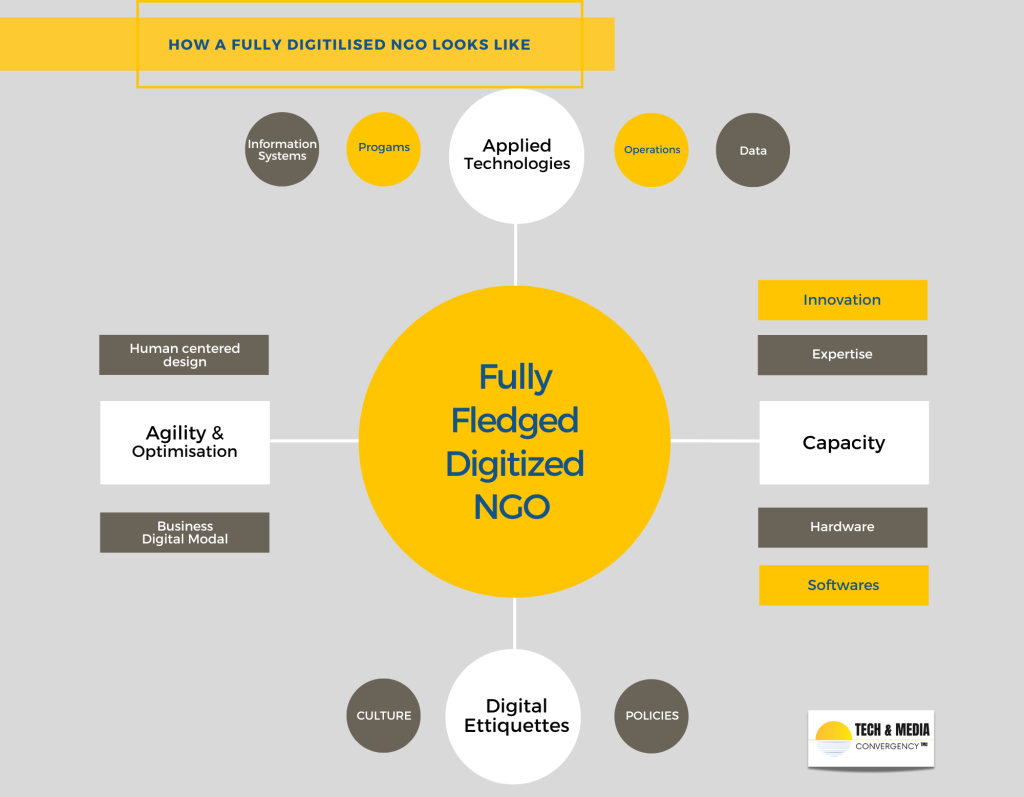The ten (10) factors impeding Technology Integration for NGOs
Executing the Foundation for Civil Society (FCS)’s initiative titled “Enhancing Compliance & Technology Integration for NGOs” that targeted 20 NGOs from seven regions in Tanzania – provided a comprehensive ground for learnings on statutory and technology compliance for Tech and Media Convergency (TMC). The integration of technology has become imperative for organizations across all sectors, including Non-Governmental Organizations (NGOs).
From our consistent work from the last three years through the Digital NGO Accelerator program; and the program with FCS – it has been proven to us that Technology integration is no longer a luxury but a necessity for NGOs aiming to increase their efficiency, reach, and impact. As NGOs strive to address complex social, economic, and environmental issues, leveraging technology allows them to streamline operations, improve transparency, enhance communication, and effectively manage resources. Digital tools enable NGOs to collect and analyze data more efficiently, thus making informed decisions and demonstrating accountability to donors and stakeholders.

Moreover, technology empowers NGOs to expand their outreach and engagement, connecting with beneficiaries, partners, and supporters globally. By harnessing digital platforms, NGOs can amplify their advocacy efforts, mobilize resources, and foster collaborations that transcend geographical boundaries. In an era where digital literacy is crucial, integrating technology also helps NGOs build the digital capacities of their staff and communities, fostering resilience and adaptability in the face of challenges.
However, despite its critical importance, many NGOs encounter significant barriers to technology integration, which hinder their ability to fully realize these benefits.
This following are the ten key factors impeding technology integration for NGOs.
-
Staff Commitment and Voluntary Basis
Many organizations face uncertain staff commitment, with a significant number operating primarily on a voluntary basis. This reliance on volunteers increases the risk of technological setbacks, especially if senior executives miss crucial sessions. Without consistent involvement from committed staff, sustaining technological initiatives becomes challenging.
2.Dependency on Partners for Effective Compliance
Organizations often depend heavily on external partners for funding, impacting their ability to maintain effective compliance measures. This reliance can introduce challenges in adhering to regulatory standards and industry best practices, as priorities and agendas may differ between the organization and its funding partners. Such dependency can compromise the organization’s autonomy in compliance matters.
-
Lack of Professional Compliance Experts
A common internal gap is the absence of dedicated professionals with expertise in compliance matters. Without individuals possessing the necessary knowledge and experience in regulatory compliance, organizations may struggle to interpret and implement complex legal requirements effectively. This gap increases the risk of non-compliance, potentially leading to legal repercussions and reputational damage.
-
Visibility Gap and Inactive Digital Presence
Despite their commendable work, many organizations suffer from inactive digital pages, including websites and social media platforms. This lack of visibility prevents their impactful work from reaching the wider audience it deserves, limiting their ability to engage with stakeholders and attract support.
-
Ownership Ambiguity in Information Systems
Organizations relying on custom-built information systems, face a critical challenge of unclear ownership. This ambiguity poses significant risks, as these systems house vital organizational and program data without defined ownership, making them vulnerable to mismanagement and data loss.
-
Lack of Relevant ICT Policies
Only three organizations possess ICT policies, which are often outdated and irrelevant. The majority urgently need to develop and update their policies to address current technological challenges and compliance requirements. Effective ICT policies are essential for guiding the organization’s use of technology and ensuring alignment with legal and regulatory standards.
-
Absence of Personal Data Protection Measures
None of the organizations have implemented personal data protection measures, despite it being mandatory according to Tanzanian law. Establishing these measures is essential for safeguarding sensitive personal information, ensuring compliance with legal requirements, and protecting the organization’s reputation.
-
Limited Strategic Approach to Technological Adaptation
While organizations adopt mandatory technologies, there is a lack of intentional mechanisms for integrating digital transformation and technological adaptation into their overall strategy. A more strategic approach is necessary for sustained technological growth and to fully leverage the benefits of new technologies.
-
Challenges in Data Storage and Retrieval
The majority of organizations struggle with systematic data and information storage, often relying on manual methods. This lack of organized data storage hinders access to past successes and impedes efficient information sharing within the organization. Developing robust data storage and retrieval systems is crucial for operational efficiency and informed decision-making.
-
Insufficient Training and Capacity Building
Many organizations lack the necessary training programs and capacity-building initiatives to equip their staff with the skills required to effectively use and manage new technologies. Without ongoing training and professional development, staff members may struggle to keep up with technological advancements, resulting in suboptimal utilization of digital tools and resources. This gap highlights the need for continuous education and skill enhancement to ensure that organizations can fully leverage technology to achieve their missions.
For more details and information about the Digital NGO Program, you can search the words “Digital NGO” on the TMC website and also visit the link – https://linktr.ee/digitalngo

